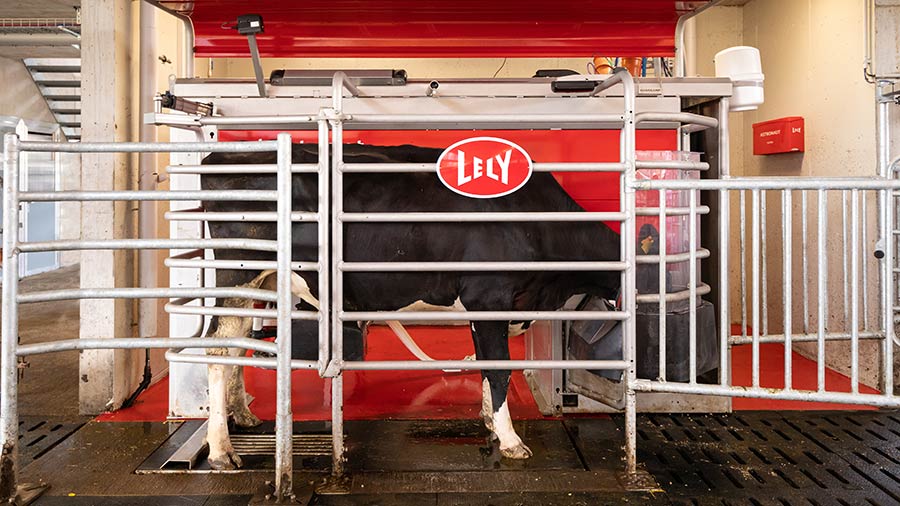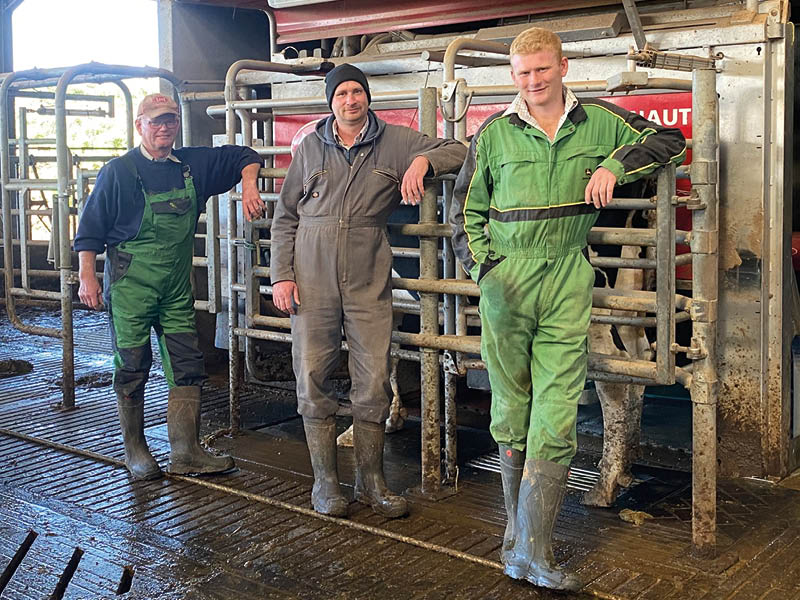How to train heifers in robotic milking systems
 © Lely
© Lely Investing time in training heifers to milk through a robot is paying dividends for a Somerset dairy.
Introducing heifers to robots pre-calving has reduced stress and ensured a smooth transition into the milking herd.
See also: How to make the most of technical data from robots
Mark Tibbs – who farms alongside nephews Denis and Lewis at Stanton Drew, near Bristol – previously pushed heifers through the robot after calving.
But they found it was too big a change; not only were heifers being milked for the first time, but they were also moving from loose housing to cubicles and being introduced to the main herd.
Now heifers are moved to the milking shed one month prior to calving, where they spend three to four days familiarising themselves with their new surroundings.
Farm facts
- Milks 160 cows
- Yields 11,500 litres at 4.5% butterfat and 3.3% protein
- Supplies Arla
- Three Lely A4 robots
- All-year-round calving
- In-calf heifers and dry cows grazed during the summer
- Farms 304ha (750 acres), part-owned and part-rented
- Grows maize, grass, wheat, barley and rape
- Four full-time staff
How the training works
Heifers receive a Lely collar and, to start with, are gently walked through the robot.
“We open the entry and exit gates and let them walk straight through,” explains Denis.
The amount of time inside the robot is gradually built up by using the robot’s heifer training mode, which is part of the Horizon software package.
This sees the heifer shut inside the robot for three minutes and given 0.5-0.75kg of concentrate while the robot mimics milking.
During this time, the robot arm and brushes move and the machine switches on, so animals become accustomed to the noise of pulsation, but the udder is not touched.
The training is normally done in the morning by one person, while the main herd is locked in yokes for service and health checks.
This is repeated for three to four days until the heifer is settled. She is then drafted back into the calving pen until calving, when she returns to the milking shed to be milked.

Mark, Denis and Lewis Tibbs © Tibbs family
Benefits of milking through robots
Although the heifers are moving an extra time, the Tibbses believe it is less stressful compared to introducing them post-calving, as was the case previously.
Denis explains: “When we first started milking through robots, we weren’t doing any heifer training and it didn’t go well. Heifers wouldn’t [take to the robot] quickly.”
The process has been developed over time, but it is paying dividends, with heifers regularly visiting the robot of their own accord on the second visit.
“It is really important the heifer doesn’t have a bad experience in the robot because they do not forget,” says Denis.
Genetics for a robotic system
While training is vital to help with this transition, the planning starts before conception, with genetic traits specifically selected to ensure heifers are well suited to a robotic system.
The Tibbses run a mating programme with Alta Genetics and select bulls that have good daughter teat placement, positive milk speed, correct feet and legs, and a good temperament.
“A lot of the semen companies now sell bulls that are compatible with robots, which makes it easier to select genetics,” explains Mark.
“The only thing we do suffer with sometimes is that front teats can be a bit lower than the back teats, and also swollen after calving, which means the laser can’t pick them up, so you have to guide them on with your fingers for a few days until the swelling subsides.”
Heifers are served to sexed semen up to twice and then, if they are still not in-calf, they receive Angus semen. Pregnancy rate across the herd averages 20%.
After three services, any cows not in-calf are put to beef. Any animals that are PD-negative are put onto an oestrus synchronisation programme.
Herd expansion plans
The herd has been hit with a TB outbreak and has lost 120 head.
To counter this, the Tibbses have been forced to double the number of replacement heifers from 30 to 60 and have had to buy in heifers to meet demands.
They have carried out three gamma tests in the past 18 months, and hope they are over the worst of it and can get back on track with herd expansion plans.
The goal is to increase numbers to 240 cows in milk.
They have erected a new dry cowshed so the current dry cow area, which is housed in the same shed as the robots, can be converted to cubicles to accommodate a fourth robot.
The stress of TB testing has also prompted them to commission a new handling system.
The Tibbses only converted to robots in 2017, when they replaced their “dilapidated” six-a-side herringbone parlour.
However, they say they have not looked back since and believe investing that time at the start with heifers ensures a smooth transition.
“Some people install robots for the wrong reasons, but if you don’t want to spend time with the cows the best thing to do is get out of milk,” says Mark.
“With robots you still must spend time with the cows, it’s just spent differently. It takes time to do the training, but it saves time in the long run.”
In numbers
- 20% Pregnancy rate
- 38% Replacement rate (higher than normal due to TB)
- 3 Average number of visits a cow a day
- 38 litres Daily milk production average a cow a day
- 3-4 days Time spent training heifers pre-calving
